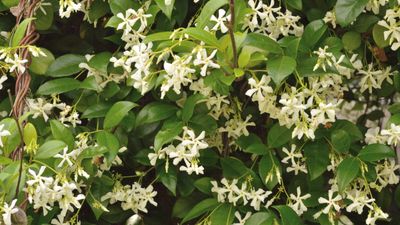Jasmine Vines for Zone 7
True jasmine (Jasminum officinale) is also known as hardy jasmine. It is hardy to USDA zone 7 and can sometimes survive in zone 6. It is a deciduous vine and a popular species. If it gets a sufficient chilling period in the winter, the vine fills with small white flowers in spring through autumn. The flowers then fill your backyard with a delicious fragrance. Hardy jasmine for zone 7 is a vine, but it needs a strong structure to climb. With the proper trellis, it can get 30 feet (9 m.) high with a spread of up to 15 feet (5 m.). Otherwise, it can be grown as a fragrant groundcover. When you are growing jasmine vines for zone 7, follow these tips on plant care:
Plant the jasmine in a site that gets full sun. In warmer zones, you can get away with a location providing sun only in the morning. You’ll need to give the vines regular water. Every week during the growing season you should provide sufficient irrigation to moisten the top 3 inches (7.5 cm.) of soil. Hardy jasmine for zone 7 also needs fertilizer. Use a 7-9-5 mix once a month. Stop feeding your jasmine plants in autumn. Follow the label directions when you apply fertilizer, and don’t forget to water the plant first. If you live in a cold pocket of zone 7, you may need to protect your plant during the coldest parts of winter. Cover the jasmine vines for zone 7 with a sheet, burlap, or a garden tarp.
Varieties of Hardy Jasmine for Zone 7
In addition to true jasmine, you can also try a few other jasmine vines for zone 7. The more common of these include: Winter jasmine (Jasminum nudiflorum) is an evergreen, hardy down to zone 6. It offers bright, cheerful yellow flowers in winter. Alas, they have no fragrance. Italian jasmine (Jasminum humile) is also an evergreen and hardy to zone 7. It also produces yellow flowers, but these have a slight fragrance. These jasmine vines for zone 7 grow 10 feet (3 m.) tall.
